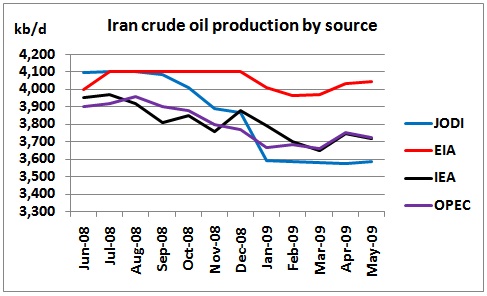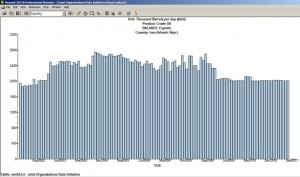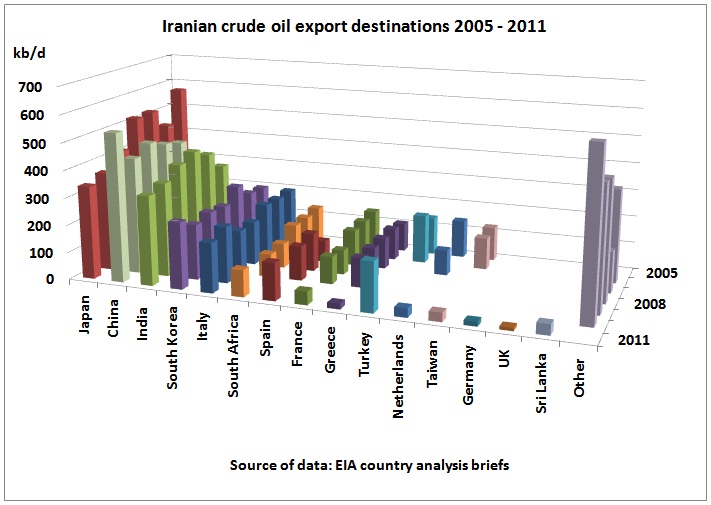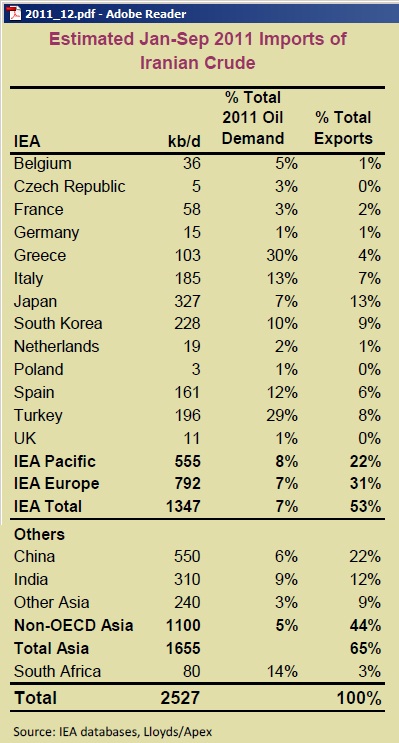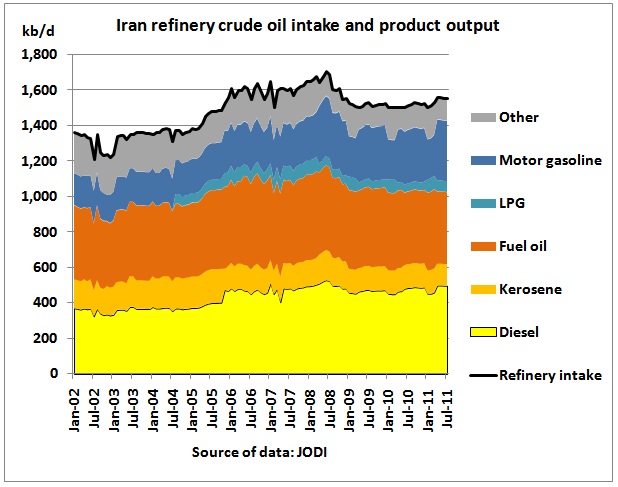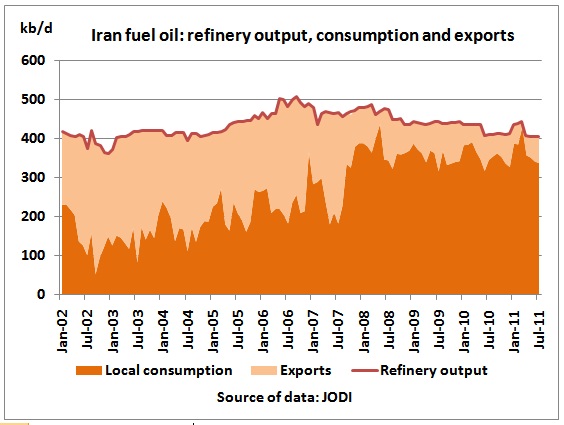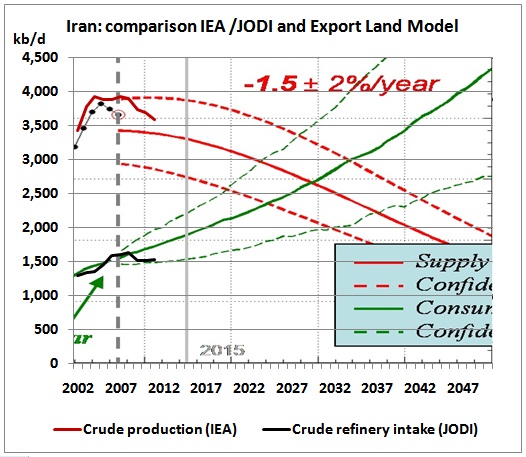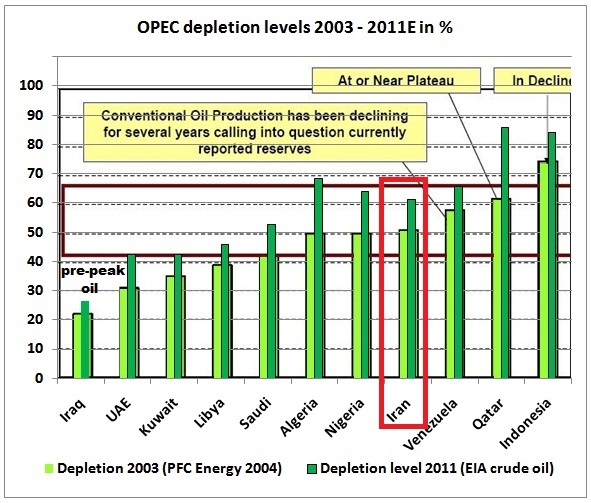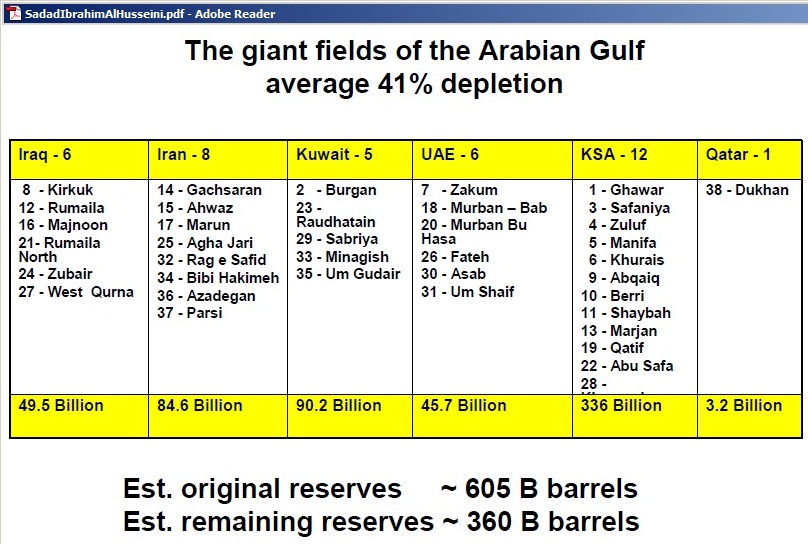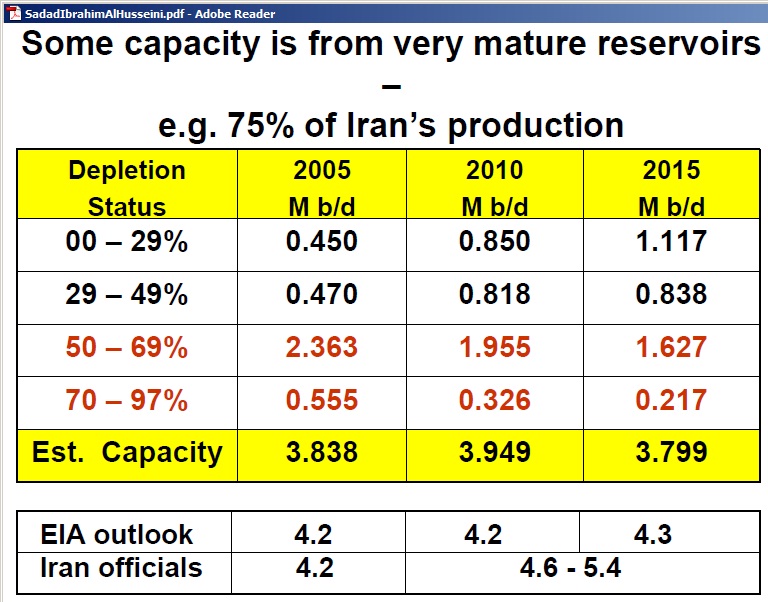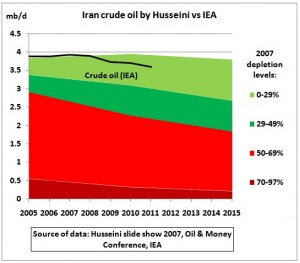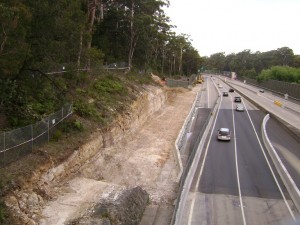As the world enters year 8 of peak oil with wafer thin spare capacity to offset any supply disruptions, war games around the heart of the Middle East oil supply system are absolutely dangerous. There may be miscalculations one day and the conflict gets out of control. One possible scenario is a stray “test” missile hitting a tanker, for example. We are concerned here with the Iranian oil supply situation:
- crude oil production has already peaked in 2008
- crude oil exports have also peaked at the same time
- petrol consumption has peaked in 2007
- petrol rationing and price increases as a result of the removal of subsidies has put motorists under pressure with the potential to spark social unrest
- sanctions in response to Iran’s attempts to develop nuclear weapons have impacted on oil production and the planned expansion of refinery capacities for local consumption
In other words, this situation is unlikely to get better.
Those who know the UK born Australian singer John Paul Young (world hit in 1978: “Love is in the air”) may remember his 1984 song (.mp3, 600 k) War Games which inspired me for the title of this post.
It is advisable to voluntarily get away from oil as fast as possible – to use the words of IEA Chief economist Fatih Birol – “before the oil gets away from us”. That could happen very fast indeed if the ME ends up in a military confrontation. But governments still continue business as usual – shown for example in updated images of the M2 toll-way widening in Sydney at the end of this article.
(1) The situation in the Gulf
This changes daily, but these are recent events:
2/1/2012
Iran has test-fired two “long-range” missiles during naval exercises near the Strait of Hormuz, state media reported.
“We have test fired a long-range shore-to-sea missile called Ghadr [Capable], which managed to successfully destroy predetermined targets in the Gulf,” the official IRNA news agency quoted Deputy Navy Commander Mahmoud Mousavi as saying on Monday.
Later, state television quoted him as saying: “Today our Nour [Light] surface-to-surface long-range missile was also successfully launched.”
http://www.aljazeera.com/news/middleeast/2012/01/20121273047336215.html
The latest brinkmanship was triggered by new US sanctions in response to an earlier IAEA report that Iran could be on the path to developing nuclear weapons:
Obama signs Iran sanctions bill into law
31 December 2011
US President Barack Obama has signed into law a major defence bill including tough new sanctions against Iran. The law cuts off from the US financial system foreign firms that do business with Iran’s central bank.
http://www.bbc.co.uk/news/world-us-canada-16376072
Although this post is not about military scenarios, maps are essential to understand the situation. Note that shipping lanes are very close to or even in Iranian waters as the water is deepest there.
The above map is from a report on water borne improvised explosive devices in the Strait of Hormuz http://info.publicintelligence.net/JIEDDO-Hormuz.pdf
There are many other conflicts, one of which is Iran’s South Pars gas field where gas production is needed to re-pressurize aging oil fields:
FGE says Iran’s South Pars Gas Production hit by Qatar’s Rapid North Field Development
26/12/2011 Well productivity has dropped by 50% in some new development phases of Iran’s South Pars offshore gas field, according to FACTS Global Energy (FGE).
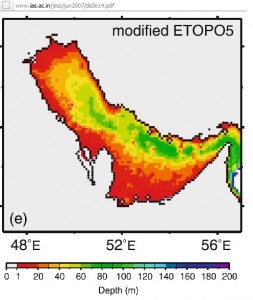 << Navigation in the Gulf is quite limited due to shallow waters (red: shallow under 20 m)
<< Navigation in the Gulf is quite limited due to shallow waters (red: shallow under 20 m)
Gulf of Conflict A History of U.S.-Iranian Confrontation at Sea
David B. Crist June 2009
http://www.voltairenet.org/IMG/pdf/US-Iranian_Confrontation_at_Sea.pdf
describes the tanker wars in 1986 – 1988 including maps showing the military geography with minefields and where ships were attacked, mostly North of Oman and the North East of the UAE
.
.
(2) Crude oil peak in Iran
This is the 2nd and final oil peak in Iran. The 1st peak in the late 70s under the Shah brought about a revolution. What will happen this time? We see it on TV every day.
While IEA and JODI data show a decline of around 400-500 kb/d, EIA data soldier on at previous levels. Applying the principles of prudent governance we have to assume that crude production has indeed peaked.
Zooming into the 2008/2009 period we can see that even OPEC statistics show a drop in production of around 300 kb/d. As of December 2011, Iranian crude production was 3.5 mb/d.
 Extract from table 5.4 of OPEC’s monthly oil market report December 2011
Extract from table 5.4 of OPEC’s monthly oil market report December 2011
http://www.opec.org/opec_web/en/publications/1979.htm
This is a graph from the December 2011 Monthly Oil market Report of the IEA:
The decline rate is 500 kb/d in 4 years = 125 kb/d pa or 3.6% pa. The IEA estimates that US and European sanctions will reduce Iran’s capacity by 890 kb/d by 2016.
(3) Crude oil export peak, too
The above graph, generated by the JODI browser, available here: http://www.jodidata.org/, shows a crude oil export peak between 2005 and 2008. Since then data are suspiciously replicated from month to month.
Let’s put that into the context of production and refinery use:
The drop in crude production and exports is clearly visible in JODI data
This graph shows the destination countries for Iranian crude over time
We see following trends: Japan (decreasing), China (growing), India (peaked and declining), Korea (increasing, but variable), Italy (flat), South Africa (decreasing), France (decreasing), Greece (flat, but slumped in 2011) and others (growing, for lack of more detailed data)
Reuters published a graph showing that Asia/Pacific takes up the reductions in Europe:
In December 2011, according to the IEA Monthly Oil Market Report, Iranian crude oil exports went to following countries:
(4) Crude oil use in Iran
Refinery intake peaked in June 2008 at 1.7 mb/d
(5) Peaking of petrol use
Petrol use first spiked in January 2007 after which petrol rationing was introduced.
27/6/2007 Iran fuel rations spark violence
http://news.bbc.co.uk/2/hi/6243644.stm
which brought down consumption, only to go up again to another spike in July 2008. We see repeated problems with refinery output and declining petrol imports reflecting a combination of various factors including the impact of sanctions and government policies to curb an underlying growth trend in consumption:
19/12/2010
Iranian riot police out in force as food and fuel subsidies end
Iranians are facing huge increases in fuel and food prices after Tehran began implementing a long-delayed plan to slash subsidies amid political controversy and fears of a fresh wave of popular unrest.
Riot police were deployed on main squares and at petrol stations in the capital and in other big cities as the new price regime came into force today.
http://www.guardian.co.uk/world/2010/dec/19/iranian-riot-police-subsidies-end
Iran’s refining capacity is stuck at these levels:
http://205.254.135.7/EMEU/cabs/Iran/images/Iran%20Refining%20Capacity.gif
Attempts are being made to increase refining capacity, but this is hampered by sanctions
3rd phase of Abadan – Iran’s largest oil refinery on stream
Abdolreza Mehrban (Director, Abadan Oil refining Co)
“Iran has many gifted individuals. It is also rich in natural resources. The prospects are so great that even if we run out of oil and gas, we can still generate income with the help of our skilled human resources” (1.2 min into the video)
http://www.youtube.com/watch?v=y4m7CXyINBM
One wonders why an Iranian official should worry about running out of oil and gas right now, given the “vast” reserves claimed in official statistics. See further down some details on Iranian oil reserves.
Iran admits to fall in oil output as EU discusses crude embargo
26/12/2011
In a rare admission of the increasing difficulties it is now facing as a consequence of mounting international sanctions, Iran revealed that its domestic crude production has dropped this year because of an investment squeeze.
http://www.mees.com/en/articles/3567-iran-admits-to-fal-in-oil-output-as-eu-discuses-crude-embargo
(6) Fuel oil export extinction
Iran used to export around 250 kb/d of fuel oil in 2002. No more. We clearly see that growing domestic demand and peaking production means declining exports.
(7) Iranian economy
The IMF published a staff report on Iran in August 2011. The Crown Centre for Middle East Studies has now prepared a critique of this IMF report saying it is too optimistic.
Is Iran’s Economy Growing?
An Assessment of the IMF’s 2011 Report on Iran
Dec 2011 Prof. Nader Habibi
http://www.brandeis.edu/crown/publications/meb/MEB57.pdf
Here are the main points which describe the situation:
7.1 Domestic manufacturing under pressure
- Imports of machinery and intermediate inputs has shifted from European to Asian suppliers.
- A sharp increase in the flow of Chinese imports puts pressure on domestic manufacturing (domestic textiles, shoes, machine made carpets and other light manufacturing)
- Government tolerates Chinese imports in exchange for oil exports, also welcomes Chinese investments in joint ventures
- US financial sanctions have forced Iran into barter trade with China.
- Cheap Chinese imports appease consumers and preserve their purchasing power. This government policy has support in the regime as it reduces the risk of urban discontent
7.2 Liberalisation and subsidy reform badly managed
- Government reneged on plan to use 20% of subsidy removal savings for compensation of the industrial sector for higher costs of fuels which were no longer subsidized.
- Instead, subsidy savings are used to pay $40 per person per month which exceeded the original allocation of 50%
- Trade unions and industry representatives complained but it remains to be seen whether there will be sufficient savings to fulfil earlier commitments
- A price freeze was imposed on local manufacturers to reduce the risk of high inflation after subsidy removal. Domestic manufacturers therefore cut back on activities, suffered from financial losses or closed shop altogether. Efficiency gains from subsidy removal will take longer to work through the economy
7.3 Sanctions result in more government control
- Sanctions on banking transactions – which are vital for the transfer and clearance of import/export payments – have become more intrusive and disruptive since 2008.
- They discourage foreign investments in key industries such as oil and gas.
- A main worry for the government is that hardship caused by sanctions may fuel public discontent and destabilize the regime. As a result, the government spends a large portion of oil revenues to appease the public. This counteracts the implementation of the subsidy reforms.
- Sanctions are used by the government as an argument to exert more control over the economy. The Iranian Revolutionary Guards Corps has bought many private companies which could not survive the sanctions or other economic problems. The IRGC also acquired shares in former state companies which were privatized, giving them an advantage in getting government contracts, especially where foreign contractors could not participate in bidding because of the sanctions.
7.4 Governance problems
- Corruption, nepotism and other government interventions in lending policies of banks have lead to non-performing loans.
- Rivalries between the President and the Parliament result in inconsistent economic policies and uncertainties for the economy.
7.5 No collapse of economy
- Despite the above mentioned flood of imports from China oil revenues have always exceeded the cost of imports, resulting in a current account surplus since 2000 which has accumulated to foreign currency reserves of $90 bn in 2011. External debt is therefore at very low levels. The above mentioned government control over the economy allows it to buy needed imports through inofficial channels and smuggling.
- The economy has adapted to the sanctions. Full production stoppages have not occurred although production costs and inefficiencies have increased. Some imports have been replaced by local production.
- Despite thousands of young qualified professionals leaving the country there is a large pool of skilled job seekers available for domestic industries. Many start their own business, including women in the service sector. Extreme poverty has been reduced and population growth rates have come down from 3.9% in 1986 to 1.3% in 2009.
Inflation rate
Iran inflation at 20%
11/12/2011
The Central Bank of Iran (CBI) reported today that the country’s annual inflation rate for the period ending 20 November has reached 19.8 percent [IRNA, 11 December].
http://www.uskowioniran.com/2011/12/iran-inflation-at-20.html
Time series on inflation and unemployment
http://blog.securities.com/wp-content/uploads/2011/12/iran-inflation.jpg
Rial in free fall
IRNA, the country’s official news agency, reported that the market exchange rate was at 16,400 rials to the dollar in mid-day trading [IRNA, 2 January]
The rial has lost nearly 55% of its value against the US dollar since January 2011, when it was traded at 10,850 to the dollar.
http://www.uskowioniran.com/2012/01/rial-loses-7-in-value-in-2-days.html
(8) Dr. Bakhtiari’s estimate
We compare actual IEA and JODI data with Dr. Bakhtiari’s 2003 estimate:
 Actual crude production in 2011 (IEA) was in the medium range between Dr. Bakhtiari’s lower and higher estimate. Refinery intake (JODI) stalled at around 1.5 mb/d.
Actual crude production in 2011 (IEA) was in the medium range between Dr. Bakhtiari’s lower and higher estimate. Refinery intake (JODI) stalled at around 1.5 mb/d.
(9) Land Export Model
We insert the IEA and JODI data in Jeff Brown’s Land Export Model with Fig 9 on Iran, as described here:
http://www.graphoilogy.com/2008/01/quantitative-assessment-of-future-net.html
We see that actual data are on the lower estimate for demand (green) and slightly above the average of the production estimate.
(10) Paper barrels
Iran is part of OPEC which increased its oil reserves artificially in the so-called quota war of the 1980s. This is well known and the following graph is from the IEA WEO Outlook 1998,
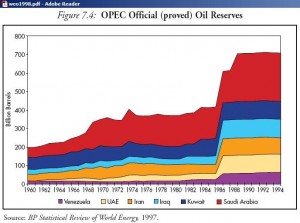 downloadable from the archive web site http://www.iea.org/weo/archives.asp
downloadable from the archive web site http://www.iea.org/weo/archives.asp
Iran’s share to this ticking time bomb can be clearly seen (orange)
(11) Depletion level
Based on the OPEC depletion levels calculated from PFC data presented at the CSIS in Washington in 2004
http://www.energybulletin.net/node/2390
The 2011 production data are taken from the EIA (up to August) and then estimated for the full year. (JODI data are incomplete to do this calculation, but the result will be similar given the size of the cumulative production). What is important here is the magnitude of the depletion and the widely differing depletion levels in OPEC countries which will determine their policies. For example, Iran may not allow Iraq to produce its pre-peak oil at full capacity if that would bring down oil prices. The Iraq war in 2003 was largely about the “coalition of the willing” getting access to that oil.
(12) Depletion warning at Oil & Money conference 2007
These are 2 slides from ex Saudi Aramco chief Sadad-al-Husseini on Iran’s oil depletion
84.6 Gb of original reserves in Iran’s giant oil fields, compared to 110 Gb for all fields in the PFC estimate. This could be in the right ballpark. The 2nd slide is on production decline:
According to Husseini, official production is higher than actual, by around 400 kb/d
Let’s put that into a graph and compare this 2007 estimate with production using IEA data:
We see that Husseini’s estimate was on the optimistic side, but he notes in one of his slides: “The Arabian Gulf has the resources, but regional turmoil undermines growth”.
The production weighted depletion rate in 2005 was 55%, which should now be higher, also similar to the above calculations
Conclusion:
In this peak oil zero-sum game, the world uses Iranian crude oil exports at the expense of the Iranian economy and the Iranian motorist in particular, a development which risks social unrest in a country of 74 million, with a capital Tehran of almost 8 million. The Iranian government is squeezed in between declining crude oil production, an underlying trend of growing local oil demand – which the Iranian government has to curb for budget reasons – and Western countries trying to use sanctions to stop Iran from developing nuclear weapons. This situation is unlikely to be resolvable any time soon and in fact will be harder and harder to deal with as oil depletion takes hold and overwhelms the system.
Previous posts on Iran:
17/8/2011 Iran crude oil decline to 2016
http://crudeoilpeak.info/iran-crude-oil-decline-to-2016
6/6/2011 Iran needs $60 bn from foreign banks to stop 1 mb/d oil production drop by 2015. Anyone interested?
30/12/2010 Another warning on Iran’s oil production and exports
http://crudeoilpeak.info/another-warning-on-iran%e2%80%99s-oil-production-and-exports
3/7/2010 Iran needs $130 oil to balance budget IEA: Iran’s crude oil production to decline by 700 Kb/d by 2015
http://crudeoilpeak.info/iran-crude-oil-production-to-decline-by-700-kbd-by-2015-budget-neutral-oil-price-130
Iran crisis does not deter Sydney to widen its tollways:
If you think that peak oil and the geopolitics in the Middle East would bring governments to a strategy “away from oil”, your are wrong. This is for the record to document peak oil denial by the NSW government. What is certainly thought to be a X’mas present to the electorate:
21/12/2011 M5 widening to ease traffic congestion
The premier, Barry O’Farrell, and the roads minister, Duncan Gay, will announce the $400 million project at a press conference at Parliament House today.
http://smh.drive.com.au/roads-and-traffic/m5-widening-to-ease-traffic-congestion-20111221-1p4hb.html
Well, declining oil production will ease traffic congestion – without toll-way widening.
Many of the above developments should have been anticipated by governments since 2006, when the late Dr. Ali Bakhtiari, who worked many years in the Iranian National Oil Company, explained peak oil to a Senate Inquiry on oil supplies.
http://www.aph.gov.au/hansard/senate/commttee/S9515.pdf
While the world braces itself for oil shortages in the event of an armed conflict in the Gulf, in Sydney – which seems to lie on a different planet and can always import oil from somewhere else – business as usual continues with the widening of toll-ways, here the M2:
What’s worse, several massive concrete columns are now blocking a strategic bus ramp near a rail hub which is still scheduled to be pulled down later in the year. This will be bitterly regretted when the first shots are fired in the Gulf. It’s yet another candidate for the “I told you so” menu on this website.



